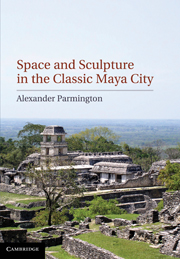Book contents
- Frontmatter
- Contents
- List of illustrations
- List of tables
- Summary
- Acknowledgements
- Introduction
- 1 Defining the Maya built environment
- 2 Investigative considerations and methodology
- 3 Access analysis of the Palenque Cross Group and its sculpture
- 4 Architectural and sculptural programs of the Palenque Palace Group
- 5 Access analysis of the architectural and sculptural programs of the Palenque Palace Group
- 6 Access analysis of Maya art and architecture: Summary and conclusions
- Appendixes 1–7
- Bibliography
- Index
6 - Access analysis of Maya art and architecture: Summary and conclusions
Published online by Cambridge University Press: 05 August 2011
- Frontmatter
- Contents
- List of illustrations
- List of tables
- Summary
- Acknowledgements
- Introduction
- 1 Defining the Maya built environment
- 2 Investigative considerations and methodology
- 3 Access analysis of the Palenque Cross Group and its sculpture
- 4 Architectural and sculptural programs of the Palenque Palace Group
- 5 Access analysis of the architectural and sculptural programs of the Palenque Palace Group
- 6 Access analysis of Maya art and architecture: Summary and conclusions
- Appendixes 1–7
- Bibliography
- Index
Summary
Access analysis of Maya building groups, together with thematic inquiry of monumental art, has provided a means of further assessing the role that imagery played in signaling how space was used and socially demarcated in Classic Maya city centres. At the beginning of this inquiry, I argued that, because of limitations in the breadth of literacy among the Classic Maya (a.d. 250–900; Marcus 1992b: 230), an alternative means would have been required to transmit doctrine to the wider population. One of the methods that the Maya elite would have used to communicate to the broader masses in city centres was with the strategic placement of sculpture and other iconographic media, in effect using monumental art as a form of “signposting” and as a means of signaling the function and hierarchical divisions in ritual and administrative spaces in city centres.
The objective of my investigation was to determine whether a spatial analysis of sculpture within a Classic Maya centre would influence current proposals that define elite-civic demarcation and area function, sustained by ethnohistoric, artefactual, and epigraphic assessment. As previously stated, I saw value in a study establishing whether imagery, as displayed on monuments and architecture, could further contribute to our understanding of social order and control within important Maya sites. Results of my analysis of sculpture and other artwork associated with the earlier phases of the Palace Group, as well as the Cross Group temples at Palenque, do suggest a correspondence between the thematic variations present in Classic Maya art and differences in the accessibility of that art.
- Type
- Chapter
- Information
- Space and Sculpture in the Classic Maya City , pp. 174 - 180Publisher: Cambridge University PressPrint publication year: 2011



